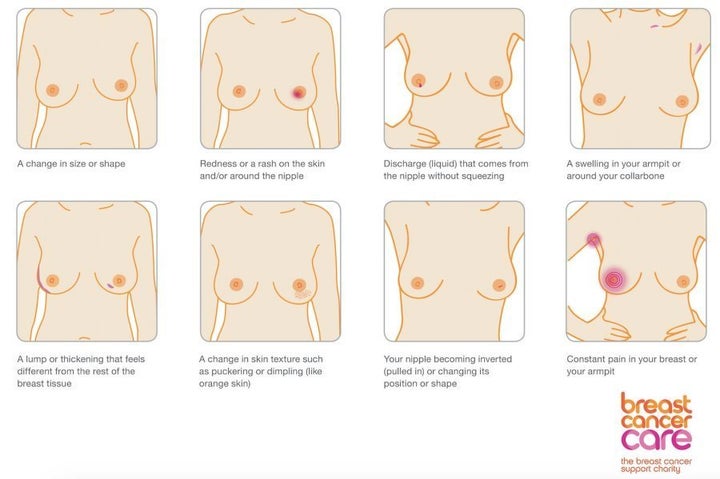It’s thought one in eight women and one in 870 men will be diagnosed with breast cancer in their lifetime.
While it’s well-known that a lump in the breast could be a sign of the disease, there are many lesser-known symptoms that women (and indeed, men) should be aware of, as treatment is more successful if it’s detected early.

Symptoms
Cancer Research UK’s health information officer, Fiona Osgun, said: “A lump isn’t the only symptom of breast cancer and not all people with breast cancer develop one.”
Aside from a lump or thickening in the breast or armpit, “other symptoms include a change in the size, shape or feel of a breast; skin changes like puckering or redness; nipple discharge; changes to the position of the nipple; or pain in a breast”.
A rash on or around the nipple might also indicate something isn’t right, according to NHS Choices. Likewise, if the nipple appears to sink into the breast. If you have any of these symptoms you should book in to see your GP.

Diagnosis
Some women are diagnosed after routine breast screening by the NHS, which begins at age 50, while other people are diagnosed simply after spotting unusual symptoms and visiting their GP.
With the latter, a doctor will examine the area in question and, if they think the symptoms need further assessment, they’ll refer patients to a specialist breast cancer clinic.
People referred by their doctor will usually have a mammogram first, and may need an ultrasound if they’re a woman aged 35 or under (as the breasts are denser and therefore mammograms aren’t necessarily as effective). If the cancer was detected through the NHS Breast Screening Programme, patients may need to have another mammogram or ultrasound scan to confirm the diagnosis.
Breast cancer specialists might also recommend a biopsy, where a sample of tissue cells is taken from the breast and tested for cancer; or a scan of the lymph nodes in the armpit.
Treatment
Like many types of cancer, treatment varies depending on the aggressiveness and stage of the condition, as well as the patient’s general health and if they’re a woman, whether they have reached the menopause.
Following diagnosis, patients should be assigned to a multidisciplinary team, according to NHS Choices, which is a team of specialists who work together to provide treatment and care.
The main treatment options are surgery to remove the tumour, chemotherapy (anti-cancer medication to kill cancer cells) or radiotherapy (doses of radiation to kill cancer cells). Sometimes surgery is followed by chemo or radiotherapy.
Other options include hormone treatment, which works by lowering the levels of hormones in the body or by stopping their effects; and biological therapy (also known as targeted therapy), which works by stopping the effects of HER2, a protein which stimulates breast cancer growth, and helping the immune system to fight off cancer cells.
According to Breast Cancer Now, complementary therapies like relaxation techniques, massage and acupuncture might be recommended - not to cure the cancer, but to improve wellbeing during treatment.
It’s worth noting patients might have one or more of these treatments.